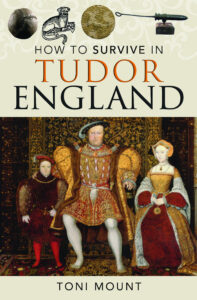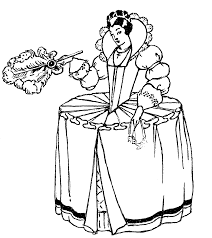 A big welcome to the Anne Boleyn Files to historian and author Toni Mount!
A big welcome to the Anne Boleyn Files to historian and author Toni Mount!
Toni is sharing an article with us today as part of the blog tour for her latest book How to Survive in Tudor England. Over to Toni…
In writing my new book How to Survive in Tudor England I realised how tricky it was to be fashionable during the sixteenth century: hard work and expensive for women. So here’s a taster of what was required to get noticed at court.
There are four basic layers to women’s clothing. You begin with the chemise, also known as the smock or shift. This is a loose garment, around knee-length and without any shaping. It’s made of linen or, as the century progresses, cotton. The idea is that it soaks up perspiration and is changed and washed frequently, keeping your more elaborate and expensive over-garments from getting smelly.
Your second layer consists of a bodice or corset and a petticoat. The bodice is usually of tight-fitting linen and sleeveless. It may be stiffened with layers of buckram or with strips of whalebone to give support to the breasts and create the required profile. It is fastened by being laced together through eyelets: front lacing is easiest but, if you have servants to assist you, side or back-lacing gives a smoother appearance. The petticoat is a plain drawstring underskirt. In 1554, the wardrobe accounts of Queen Mary Tudor lists a new petticoat for her majesty of scarlet with a bodice of crimson taffeta.
The third layer is your kirtle and, depending on fashion, parts of this garment may be on show, so a more expensive cloth is used. It has long fitted sleeves and is shaped to the upper body. For Anne Boleyn’s coronation in June 1533, her kirtle is made of five yards of white satin lined with two and a half yards of red cloth, type unspecified.
Before we come to the fourth layer, the gown, you will also require knee-length stockings: woolly ones, if you’re poor; silk, if you can afford them. These are held up with garters, perhaps of ribbon – there’s no elastic – or grand ones with ‘buckles and pendants of gold’ like those worn by uncrowned Queen Jane Grey when imprisoned in the Tower of London. Even as prisoners, royals have to keep up appearances and she has a perfumed purse made of sable skin sent to her as well.
Now we come to the gown, also known as the surcoat. This is what everyone will see and it needs to impress, if you want to be noticed at court. Courtiers bankrupt themselves and their families, squandering their inheritances trying to outshine the likes of Robert Dudley who spends £563 in one wardrobe spree, buying seven doublets and two cloaks.
For her coronation in 1533, Anne Boleyn wore a gown ‘of right crimson satin lined with cloth of gold tissue’. I’m not sure what ‘right crimson’ is or maybe it’s a typo and should say ‘bright’. Whatever the case, crimson satin must look gorgeous set off with a gold lining which would be intended to show here and there.
![Tudor gown of the type worn by Anne Boleyn [c.1533]](https://www.theanneboleynfiles.com/wp-content/uploads/2023/10/Anne-Boleyn-type-gown.jpg)
The rich may wear cloth of gold or silver, damask, silk-velvet, tinselled satin, finest wool embroidered with gold, silver and silk thread and then trimmed or lined with imported furs, such as black sable, white arctic fox or spotted lynx. The making of a Tudor gown involves many hands, from dyers and weavers, haberdashers and cloth merchants, to tailors and seamstresses. Then the gown requires embellishment by embroiderers, goldsmiths and jewellers to add the finishing touches with brooches, pendants, earrings, ropes of pearls – Queen Elizabeth loved pearls as symbols of her virginity – and hair ornaments.
So that covers the basics but other items of apparel may be in fashion at various dates. The bum-roll or ‘rowle’ goes between the petticoat and the kirtle, tied around the waist to make the kirtle and gown flare out behind. But as the Tudor period progresses, this is replaced by the more significant farthingale. The Spanish farthingale is a conical hooped underskirt, fashionable at the court of Henry VIII and worn by all his queens. The French farthingale is barrel-shaped, fanning straight out at waist level, like the spokes of a cartwheel, and is popular at Elizabeth I’s court, if far less practical for everyday wear.

Then there are the partlet, stomacher and forepart – each required depending on the demands of the fashionable design of the gown. The partlet is like a delicate blouse with short sleeves, often of almost transparent cloth. In the reigns of both Henrys, ladies’ necklines are square and so wide that the shoulders are in danger of slipping down and revealing too much. The partlet is worn under the gown so the shoulders can be pinned to it and modesty is preserved.
The stomacher is a large triangle which is pinned or laced to the centre of the bodice of the kirtle and the forepart is an inverted triangle similarly fixed to the centre of the kirtle skirt. Both are often highly decorated with jewels and embroidery and are definitely meant to be seen when the gown is worn open at the front. I wonder how they originated? I’m tempted to think that someone had a length of gorgeous cloth that wasn’t quite enough to go around them, so the too little allowances in the bodice and skirt were in-filled with contrasting cloth and a new fashion created. Perhaps you can ask someone during your visit back in time.
Sleeves are another separate item. Although the kirtle has fitted sleeves, the gown may not, in which case you required ‘a pair of sleeves’. Remember the song ‘Greensleeves’, supposedly written by Henry VIII himself? Sleeves are the perfect gift for a lover to give his sweetheart and green is the colour of youth and loyalty. In the song, the abandoned lover is complaining about his dearest who has gone off with someone else, taking her new pair of green sleeves with her but such is life. Sleeves can be laced in place or simply pinned at the shoulder and may be slashed to show a contrasting lining or the sleeves of your kirtle. Since sleeves are detachable, the poor woman may remove hers when doing the washing or messy household tasks. The wealthy can mix-and-match sleeves and gowns to create a fresh look.
![From the right – George Boleyn, Katherine of Aragon [English hood], Anne Boleyn [French hood], Jane Seymour [English hood], Anne of Cleves [German style headdress], Katherine Howard [French hood] and Katherine Parr [a cap and hat]. Seated – Princess Elizabeth.
By kind permission of the Tudor Queens, taken at Penshurst Place, Kent [GRM 2021].](https://www.theanneboleynfiles.com/wp-content/uploads/2023/10/The-Tudor-Queens-300x225.jpg)
By kind permission of the Tudor Queens, taken at Penshurst Place, Kent [GRM 2021].
No lady’s outfit is complete without accessories and the most obvious is headwear of some kind. Queen Elizabeth, wife of Henry VII, and Queen Katherine of Aragon favour the English gable hood but the rounded French hood is also worn early in the Tudor period. Anne Boleyn favours the more becoming French hood but Jane Seymour reverts to the gable hood, perhaps to distinguish her profile from Anne’s. Anne of Cleves prefers the German fashion, Katherine Howard and Katherine Parr the French – to judge by their portraits. Queen Mary wears a different style of hood with a square gable, rather than pointed. In her early portraits, Princess Elizabeth wears a French hood but by the time she becomes queen, hoods are no more, replaced by elaborate hair – or wigs – and jaunty little hats. The medieval and Catholic rule of respectable women always keeping their hair out of sight is gone – at least until the Puritans enforce such modesty in the 1650s, long after the Tudor period. So at Queen Elizabeth’s court you can, quite literally, let your hair down.
Another vital accessory for the wealthy is a pair of gloves. Not labourers’ hard-wearing stout leather gloves but the daintier the better. These aren’t to keep your hands warm, in fact you don’t need to wear them but carry them prominently so everyone can see how beautiful they are. Finest kid-skin, silk or satin, tight-fitting, bejewelled and embroidered, gloves are an ideal, flattering gift for anyone, even the queen, and especially if they’re perfumed! Scented fans and purses are very fashionable. Queen Elizabeth loves to carry a fan as it’s perfect for wafting away unpleasant smells.
Now for the hair-do. If you’re not a natural red-head like the queen, nor a fashionable blonde, a mixture of saffron, cumin seed and celandine ground together in oil will soon achieve the desired effect or you could resort to wearing other people’s hair as the queen does. Elizabeth has at least eighty human-hair wigs and hair pieces in her wardrobe. These are vital as her own hair becomes thin as she ages but they’re also convenient because she can leave her stylist to work on her elaborate coiffure for tonight’s feast and banquet while she gets on with more interesting things, like playing off her would-be suitors, one against the other.

The most obvious accessory of the later Elizabethan period is the ruff, worn by both men and women of all ages and classes. What begins as a modest frill gathered onto the standing collar or band of a shirt or shift gradually grows into an impractical and absurdly huge ruff, beloved by Queen Elizabeth, if her portraits are any guide. At first, the design and size of ruffs is limited because they lay limp around the neck but an enterprising Dutchwoman, Dinghen van den Plass, comes to London as a refugee in 1564 and brings with her the art of starching linen. Only with the advent of starch does the ruff become possible. Simple neck ruffles become finer, more intricate in construction and folding, as starch becomes a vital commodity for the wealthy. Usually made from wheat flour, during times of shortage after a poor harvest, starch production means less flour for making bread. The government tries to ban its production in England but, since they also slap a heavy tax on imported starch, the eventual answer is the less extravagant neckwear of the Stuart period.
Although Queen Elizabeth is always shown in her portraits wearing a ruff of virgin white, coloured ruffs are fashionable too, usually tinted pink or yellow. However, do not be tempted to wear a blue one as these are the badge of a prostitute. So that sums up what the Tudor woman of fashion should be wearing.
If you wish to read about many interesting characters, places, food and pastimes of the sixteenth century, my new book How to Survive in Tudor England is published on 30th October 2023.
Book blurb
Imagine you were transported back in time to Tudor England and had to start a new life there, without smart phones, internet or social media. When transport means walking or, if you’re lucky, horse-back, how will you know where you are or where to go? Where will you live and where will you work? What will you eat and what shall you wear? And who can you turn to if you fall ill or are mugged in the street, or God-forbid if you upset the king? In a period when execution by be-heading was the fate of thousands how can you keep your head in Tudor England?
All these questions and many more are answered in this new guide book for time-travellers: How to Survive in Tudor England. A handy self-help guide with tips and suggestions to make your visit to the 16th century much more fun, this lively and engaging book will help the reader deal with the new experiences they may encounter and the problems that might occur.
Enjoy interviews with the celebrities of the day, and learn some new words to set the mood for your time-travelling adventure. Have an exciting visit but be sure to keep this book to hand.
Toni Mount
Toni Mount researches, teaches and writes about history. She is the author of several popular historical non-fiction books and writes regularly for various history magazines. As well as her weekly classes, Toni has created online courses for www.MedievalCourses.com and is the author of the popular Sebastian Foxley series of medieval murder mysteries. She’s a member of the Richard III Society’s Research Committee, a costumed interpreter and speaks often to groups and societies on a range of historical subjects. Toni has a Masters Degree in Medieval Medicine, Diplomas in Literature, Creative Writing, European Humanities and a PGCE. She lives in Kent, England with her husband.
